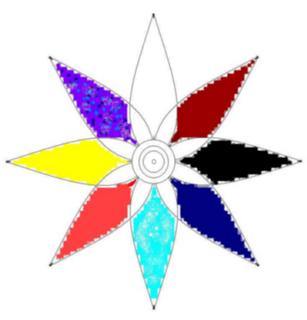Atma distinction
अथात्मनिर्णयं व्याख्यास्ये॥
athātmanirnayam vyākhyāsye ||
Shloka 94 -Dhyanabindu Upanishad
1. When it rests on the eastern petal which is of Sveta (white) colour, then it has a mind (or is inclined) to Dharma with Bhakti (devotion).
2. When it rests on the south-eastern petal, which is of Rakta (blood colour), then it is inclined to sleep and laziness.
3. When it rests on the southern petal, which is of
4. When it rests on the south-western petal which is of Nila (blue) colour, then it gets desire for sinful or harmful actions.
5. When it rests on the western petal which is of crystal colour, then it is inclined to flirt and amuse.
6. When it rests on the north-western petal which is of ruby colour, then it has a mind to walk, rove and have Vairagya (or be indifferent).
7. When it rests on the northern petal which is Pita (yellow) colour, then it is inclined to be happy and to be loving.
8. When it rests on the north-eastern petal which is of Vaidurya (Lapis Lazuli) colour, then it is inclined to amassing money, charity and passion.
When it stays in the inter-space between any two petals, then it gets the wrath arising from diseases generated through (the disturbance of the equilibrium of) Vayu, bile and phlegm (in the body). When it stays in the middle, then it knows everything, sings, dances, speaks and is blissful. When the eye is pained (after a day’s work), then in order to remove (its) pain, it makes first a circular line and sinks in the middle.
a) The first line is of the colour of Bandhuka flower (Bassia). Then is the state of sleep. In the middle of the state of sleep is the state of dream. In the middle of the state of dream, it experiences the ideas of perception, Vedas, inference, possibility, (sacred) words, etc. Then there arises much fatigue. In order to remove this fatigue, it circles the second line and sinks in the middle.
b) The second is of the colour of (the insect) Indragopa (of red or white colour). Then comes the state of dreamless sleep. During the dreamless sleep, it has only the thought connected with Parameshvara (the highest Lord) alone. This state is of the nature of eternal wisdom. Afterwards it attains the nature of the highest Lord (Parameshvara).
c) Then it makes a round of the third circle and sinks in the middle. The third circle is of the colour of Padmaraga (ruby).
d) Then comes the state of Turya (the fourth). In Turya, there is only the connection of Paramatman. It attains the nature of eternal wisdom. Then one should gradually attain the quiescence of Buddhi with self-control. Placing the Manas in Atman, one should think of nothing else. Then causing the union of Prana and Apana, he concentrates his aim upon the whole universe being of the nature of Atman. Then comes the state of Turiyatita (viz., that state beyond the fourth). Then everything appears as bliss. He is beyond the pairs (of happiness and pains, etc.,). He stays here as long as he should wear his body. Then he attains the nature of Paramatman and attains emancipation through this means. This alone is the means of knowing Atman. When Vayu (breath) which enters the great hole associated with a hall where four roads meet gets into the half of the well-placed triangle, then is Achyuta (the indestructible) seen.
Translated by K. Narayanasvami Aiyar

| Direction/Dig | Color | Nature |
| East | White(Sweta) | Dharma with Bhakti (devotion). |
| South-East | Red(Rakta) | Sleep and laziness |
| South | Black( | Hate and anger |
| South-West | Blue(Nila) | Sinful or harmful actions |
| West | | flirt and amuse |
| North-West | Ruby | Walk, rove and have Vairagya |
| North | Yellow(Pitta) | happy and loving |
| North-East | Lapis Lazuli (Vaidurya) | amassing money, charity and passion |
हृदिस्थाने अष्टदलपद्मं वर्तते तन्मध्ये रेखावलयं कृत्वा जीवात्मरूपं ज्योतीरूपमणुमात्रं वर्तते तस्मिन्सर्वं प्रतिष्ठितं भवति सर्वं जानाति सर्वं करोति सर्वमेतच्चरितमहं कर्ताऽहं भोक्ता सुखी दुःखी काणः खञ्जो बधिरो मूकः कृशः स्थूलोऽनेन प्रकारेण स्वतन्त्रवादेन वर्तते॥ पूर्वदले विश्रमते पूर्वं दलं श्वेतवर्णं तदा भक्तिपुरःसरं धर्मे मतिर्भवति॥
यदा पश्चिमदले विश्रमते तत्पश्चिमदलं स्फटिकवर्णं तदा क्रीडाविनोदे मतिर्भवति॥ यदा वायव्यदले विश्रमते वायव्यदलं माणिक्यवर्णं तदा गमनचलनवैराग्यमतिर्भवति॥ यदोत्तरदले विश्रमते तदुत्तरदलं पीतवर्णं तदा सुखशृङ्गारमतिर्भवति॥ यदेशानदले विश्रमते तदीशानदलं वैडूर्यवर्णं तदा दानादिकृपामतिर्भवति॥
athātmanirṇayaṁ vyākhyāsye ||
hṛdisthāne aṣṭadalapadmaṁ vartate tanmadhye rekhāvalayaṁ kṛtvā jīvātmarūpaṁ jyotīrūpamaṇumātraṁ vartate tasminsarvaṁ pratiṣṭhitaṁ bhavati sarvaṁ jānāti sarvaṁ karoti sarvametaccaritamahaṁ kartā'haṁ bhoktā sukhī duḥkhī kāṇaḥ khañjo badhiro mūkaḥ kṛśaḥ sthūlo'nena prakāreṇa svatantravādena vartate ||
pūrvadale viśramate pūrvaṁ dalaṁ śvetavarṇaṁ tadā bhaktipuraḥsaraṁ dharme matirbhavati ||
yadā'gneyadale viśramate tadāgneyadalaṁ raktavarṇaṁ tadā nidrālasya matirbhavati ||
yadā dakṣiṇadale viśramate taddakṣiṇadalaṁ kṛṣṇavarṇaṁ tadā dveṣakopamatirbhavati ||
yadā nairṛtadale viśramate tannairṛtadalaṁ nīlavarṇaṁ tadā pāpakarmahiṁsāmatirbhavati ||
yadā paścimadale viśramate tatpaścimadalaṁ sphaṭikavarṇaṁ tadā krīḍāvinode matirbhavati ||
yadā vāyavyadale viśramate vāyavyadalaṁ māṇikyavarṇaṁ tadā gamanacalanavairāgyamatirbhavati ||
yadottaradale viśramate taduttaradalaṁ pītavarṇaṁ tadā sukhaśṛṅgāramatirbhavati ||
yadeśānadale viśramate tadīśānadalaṁ vaiḍūryavarṇaṁ tadā dānādikṛpāmatirbhavati ||
yadā sandhisandhiṣu matirbhavati tadā vātapittaśleṣmamahāvyādhiprakopo bhavati ||
yadā madhye tiṣṭhati tadā sarvaṁ jānāti gāyati nṛtyati paṭhatyānandaṁ karoti ||
yadā netraśramo bhavati śramanirbharaṇārthaṁ prathamarekhāvalayaṁkṛtvā madhye nimajjanaṁ kurute prathamarekhābandhūkapuṣpavarṇaṁ tadā nidrāvasthā bhavati ||
nidrāvasthāmadhye svapnāvasthā bhavati ||
svapnāvasthāmadhye dṛṣṭaṁ śrutamanumānasaṁbhavavārtā ityādikalpanāṁ karoti tadādiśramo bhavati ||
śramanirharaṇārthaṁ dvitīyarekhāvalayaṁ kṛtvā madhye nimajjanaṁ kurute dvitīyarekhā indrakopavarṇaṁ tadā suṣuptyavasthā bhavati suṣuptau kevalaparameśvarasambandhinī
buddirbhavati nityabodhasvarūpā bhavati paścātparameśvarasvarūpeṇa prāptirbhavati ||
tṛtīyarekhāvalayaṁ kṛtvā madhye nimajjanaṁ kurute tṛtīyarekhā padmarāgavarṇaṁ tadā turīyāvasthā bhavati turīye kevalaparamātma sambandhinī bhavati nityabodhasvarūpā bhavati tadā śanaiḥ śanairuparamedbuddhyā dhṛtigṛhītayātmasaṁsthaṁ manaḥ kṛtvā na kiñcidapi cintayettadā prāṇāpānayoraikyaṁ kṛtvā
sarvaṁ viśvamātmasvarūpeṇa lakṣyaṁ dhārayati | yadā turīyātītāvasthā tadā sarveṣāmānandasvarūpo bhavati dvandvātīto bhavati yāvaddehadhāraṇā vartate tāvattiṣṭhati
paścātparamātmasvarūpeṇa prāptirbhavati ityanena prakāreṇa mokṣo bhavatīdamevātmadarśanopāyaṁ bhavanti ||
catuṣpathasamāyuktamahādvāragavāyunā | saha sthitatrikoṇārdhagamane dṛśyate'cyutaḥ || 94||
REF: Dhyanabindu Upanishad Translated by K. Narayanasvami Aiyar
http://sanskrit.gde.to/doc_upanishhat/dhyanabindu.itx
http://www.yrec.info/Dhyana-Bindu-Upanishad.php